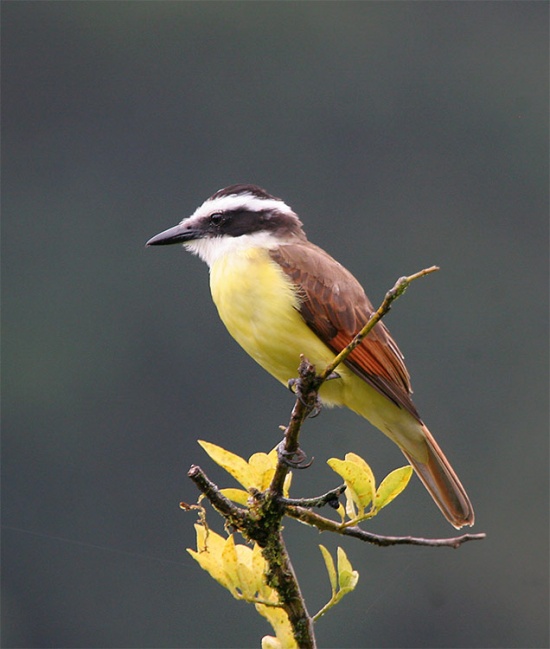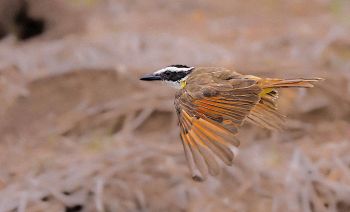m |
m (→Subspecies: Spelling) |
||
| (23 intermediate revisions by 10 users not shown) | |||
| Line 1: | Line 1: | ||
| − | + | [[Image:Great_Kiskadee.jpg|thumb|550px|right|Adult, subspecies ''P. s. guatimalensis''<br />Photo © by {{user|Reini|Reini}}<br />Laguna del Lagarto Lodge, [[Costa Rica]], February 2005]] | |
| − | [[Image:Great_Kiskadee.jpg|thumb| | + | ;[[:Category:Pitangus|Pitangus]] sulphuratus |
| − | |||
| − | |||
| − | |||
| − | |||
| − | |||
==Identification== | ==Identification== | ||
| − | Easily mistaken with the [[Boat-billed Flycatcher]] (''Megarynchus pitangua''), due to size and colours. They are separated by: | + | It's about 10 1/2" (27 cm) size. <br> |
| − | + | A stocky flycatcher with relatively broad black bill, black-and-white striped head, olive-brown back, bright yellow underparts and rufous wings. Its tail conspicuous in flight. Generally also has a yellow crown. | |
| + | ====Similar species==== | ||
| + | Easily mistaken with the [[Boat-billed Flycatcher]] (''Megarynchus pitangua''), due to size and colours. They are separated by:<br /> | ||
| + | [[Image:Bem-te-vri.jpg|thumb|350px|right|Juvenile, subspecies ''P. s. argentinus''<br />Photo © by {{user|Xyko+Paludo|Francisco Paludo}}<br />Curitiba, PR, [[Brazil]], 30 November 2016]] | ||
* Bill, which is much broader and with a strongly curved culmen in the Boat-billed Flycatcher. | * Bill, which is much broader and with a strongly curved culmen in the Boat-billed Flycatcher. | ||
| − | * Wings, which are rufous in Great Kiskadee (''see photo'') and olive in Boat-billed Flycatcher (careful; juv. Boat-billed with rufescent to wings). | + | * Wings, which are rufous in Great Kiskadee (''see photo'') and olive in Boat-billed Flycatcher (careful; juv. Boat-billed with rufescent to wings).<br /> |
| − | Can be mistaken | + | Can be mistaken for the smaller-sized similar coloured flycatcher as well, e.g. [[Rusty-margined Flycatcher|Rusty-margined]] (''Myiozetetes cayanensis'') and [[Social Flycatcher]]s (''Myiozetetes similis'') and [[Lesser Kiskadee]] (''Philohydor lictor''), but they are separated by size and their noticeably slimmer and/or shorter bills. |
==Distribution== | ==Distribution== | ||
| − | Very common and widespread throughout Latin America. In North America, occurs in extreme southern Texas and eastern and western Mexico. In South America, it is absent only from the Pacific coast, the highest Andean regions and in far south. | + | [[File:Great Kiskadee Costs Rica-SJ.jpg|thumb|350px|right|''P. s. guatimalensis''<br />Photo © by {{user|Stanley+Jones|Stanley Jones}}<br />Shrimp farm, Near Cañas, Guanacaste Province, [[Costa Rica]], 1 July, 2023]] |
| + | Very common and widespread throughout Latin America. In North America, occurs in extreme southern [[Texas]] and eastern and western [[Mexico]]. Occurs throughout [[Central America]]. In [[South America]], it is absent only from the Pacific coast, the highest Andean regions and in far south. An introduced population is found in [[Bermuda]]. | ||
| + | ==Taxonomy== | ||
| + | [[Image:21587Scan04182005 192313.jpg|thumb|350px|right|Subspecies ''P. s. argentinus''<br />Photo © by {{user|Baires|Baires}}<br />Buenos Aires, [[Argentina]], January 2005]] | ||
| + | Was initially thought to be shrike of the genus ''[[:Category:Lanius|Lanius]]'', but this idea was discarded many decades ago. | ||
| + | ====Subspecies==== | ||
| + | There are 10 supspecies recognised<sup>[[#References|[1]]]</sup>: | ||
| + | *''P. s. texanus'': Southern [[Texas]] (Rio Grande Valley) to south-eastern [[Mexico]] (Veracruz) | ||
| + | *''P. s. derbianus'': Arid western Mexico (southern Sonora to Isthmus of Tehuántepec) | ||
| + | *''P. s. guatimalensis'': South-eastern Mexico (Nuevo León) to central [[Panama]] | ||
| + | *''P. s. trinitatis'': Extreme eastern [[Colombia]] to eastern [[Venezuela]] and north-western [[Brazil]]; [[Trinidad]] | ||
| + | *''P. s. caucensis'': Western and southern [[Colombia]] (south-western Bolívar, Cauca and Magdalena valleys) | ||
| + | *''P. s. rufipennis'': Coastal northern [[Colombia]] and northern [[Venezuela]] | ||
| + | *''P. s. sulphuratus'': Tropical south-eastern Colombia to south-eastern [[Peru]], the [[Guianas]] and northern [[Brazil]] | ||
| + | *''P. s. maximiliani'': Amazonian Brazil to eastern [[Bolivia]] and chaco of [[Paraguay]] | ||
| + | *''P. s. bolivianus'': Highlands of eastern [[Bolivia]] (Cochabamba to Tarija) | ||
| + | *''P. s. argentinus'': Extreme south-eastern Brazil to eastern [[Paraguay]], [[Uruguay]] and central [[Argentina]] | ||
==Habitat== | ==Habitat== | ||
Rivers, streams, and lakes bordered with dense vegetation; also in more open country and in parks in most of its range. Very adaptable to human life in cities. | Rivers, streams, and lakes bordered with dense vegetation; also in more open country and in parks in most of its range. Very adaptable to human life in cities. | ||
| − | |||
| − | |||
| − | |||
==Behaviour== | ==Behaviour== | ||
| − | This bird has a noticeably | + | This bird has a noticeably aggressive behaviour, pursuing and attacking bigger birds or even snakes. |
| + | ====Breeding==== | ||
| + | Nest is a domed structure with side entrance made of grass and twigs. Clutch is two to five (usually three to four) whitish eggs with brown spots. | ||
| + | ====Diet==== | ||
| + | Its diet is omnivorous, consisting of, in addition to insects, small fruits and seeds and even fish, diving straight into the water like a kingfisher, although not as deeply. | ||
| + | ====Vocalistion==== | ||
| + | Loud, piercing ''kis-ka-dee'', hence its English name. Also makes an incessant, shrill chattering. In several other languages, it is called "bem-te-vi" or "bentevi", also because of its call. | ||
| + | ====Movements==== | ||
| + | Mostly resident but may leave higher elevations seasonally. | ||
| − | == | + | ==References== |
| − | + | #{{Ref-Clements6thOct22}}#Mobley, J. (2019). Great Kiskadee (''Pitangus sulphuratus''). In: del Hoyo, J., Elliott, A., Sargatal, J., Christie, D.A. & de Juana, E. (eds.). Handbook of the Birds of the World Alive. Lynx Edicions, Barcelona. (retrieved from https://www.hbw.com/node/57461 on 2 August 2019). | |
| + | #Brush, T. and J. W. Fitzpatrick (2002). Great Kiskadee (''Pitangus sulphuratus''), version 2.0. In The Birds of North America (A. F. Poole and F. B. Gill, Editors). Cornell Lab of Ornithology, Ithaca, NY, USA. https://doi.org/10.2173/bna.622 | ||
| + | #Great Kiskadee (''Pitangus sulphuratus''), In Neotropical Birds Online (T. S. Schulenberg, Editor). Cornell Lab of Ornithology, Ithaca, NY, USA. retrieved from Neotropical Birds Online: https://neotropical.birds.cornell.edu/Species-Account/nb/species/grekis | ||
| + | #Prum, R. O. (2014), Social Mimicry in Birds. Zool J Linn Soc, 172: 910-941. doi:10.1111/zoj.12192 | ||
| + | #BirdForum Member observations | ||
| + | {{ref}} | ||
==External Links== | ==External Links== | ||
| − | {{GSearch|Pitangus | + | {{GSearch|"Pitangus sulphuratus" {{!}} "Great Kiskadee"}} |
| − | [[Category:Birds]] | + | {{GS-checked}}1 |
| + | <br /> | ||
| + | <br /> | ||
| + | |||
| + | [[Category:Birds]][[Category:Pitangus]] | ||
Latest revision as of 23:35, 21 November 2023

Photo © by Reini
Laguna del Lagarto Lodge, Costa Rica, February 2005
- Pitangus sulphuratus
Identification
It's about 10 1/2" (27 cm) size.
A stocky flycatcher with relatively broad black bill, black-and-white striped head, olive-brown back, bright yellow underparts and rufous wings. Its tail conspicuous in flight. Generally also has a yellow crown.
Similar species
Easily mistaken with the Boat-billed Flycatcher (Megarynchus pitangua), due to size and colours. They are separated by:

Photo © by Francisco Paludo
Curitiba, PR, Brazil, 30 November 2016
- Bill, which is much broader and with a strongly curved culmen in the Boat-billed Flycatcher.
- Wings, which are rufous in Great Kiskadee (see photo) and olive in Boat-billed Flycatcher (careful; juv. Boat-billed with rufescent to wings).
Can be mistaken for the smaller-sized similar coloured flycatcher as well, e.g. Rusty-margined (Myiozetetes cayanensis) and Social Flycatchers (Myiozetetes similis) and Lesser Kiskadee (Philohydor lictor), but they are separated by size and their noticeably slimmer and/or shorter bills.
Distribution

Photo © by Stanley Jones
Shrimp farm, Near Cañas, Guanacaste Province, Costa Rica, 1 July, 2023
Very common and widespread throughout Latin America. In North America, occurs in extreme southern Texas and eastern and western Mexico. Occurs throughout Central America. In South America, it is absent only from the Pacific coast, the highest Andean regions and in far south. An introduced population is found in Bermuda.
Taxonomy
Was initially thought to be shrike of the genus Lanius, but this idea was discarded many decades ago.
Subspecies
There are 10 supspecies recognised[1]:
- P. s. texanus: Southern Texas (Rio Grande Valley) to south-eastern Mexico (Veracruz)
- P. s. derbianus: Arid western Mexico (southern Sonora to Isthmus of Tehuántepec)
- P. s. guatimalensis: South-eastern Mexico (Nuevo León) to central Panama
- P. s. trinitatis: Extreme eastern Colombia to eastern Venezuela and north-western Brazil; Trinidad
- P. s. caucensis: Western and southern Colombia (south-western Bolívar, Cauca and Magdalena valleys)
- P. s. rufipennis: Coastal northern Colombia and northern Venezuela
- P. s. sulphuratus: Tropical south-eastern Colombia to south-eastern Peru, the Guianas and northern Brazil
- P. s. maximiliani: Amazonian Brazil to eastern Bolivia and chaco of Paraguay
- P. s. bolivianus: Highlands of eastern Bolivia (Cochabamba to Tarija)
- P. s. argentinus: Extreme south-eastern Brazil to eastern Paraguay, Uruguay and central Argentina
Habitat
Rivers, streams, and lakes bordered with dense vegetation; also in more open country and in parks in most of its range. Very adaptable to human life in cities.
Behaviour
This bird has a noticeably aggressive behaviour, pursuing and attacking bigger birds or even snakes.
Breeding
Nest is a domed structure with side entrance made of grass and twigs. Clutch is two to five (usually three to four) whitish eggs with brown spots.
Diet
Its diet is omnivorous, consisting of, in addition to insects, small fruits and seeds and even fish, diving straight into the water like a kingfisher, although not as deeply.
Vocalistion
Loud, piercing kis-ka-dee, hence its English name. Also makes an incessant, shrill chattering. In several other languages, it is called "bem-te-vi" or "bentevi", also because of its call.
Movements
Mostly resident but may leave higher elevations seasonally.
References
- Clements, J. F., T. S. Schulenberg, M. J. Iliff, T. A. Fredericks, J. A. Gerbracht, D. Lepage, S. M. Billerman, B. L. Sullivan, and C. L. Wood. 2022. The eBird/Clements checklist of Birds of the World: v2022. Downloaded from https://www.birds.cornell.edu/clementschecklist/download/
- Mobley, J. (2019). Great Kiskadee (Pitangus sulphuratus). In: del Hoyo, J., Elliott, A., Sargatal, J., Christie, D.A. & de Juana, E. (eds.). Handbook of the Birds of the World Alive. Lynx Edicions, Barcelona. (retrieved from https://www.hbw.com/node/57461 on 2 August 2019).
- Brush, T. and J. W. Fitzpatrick (2002). Great Kiskadee (Pitangus sulphuratus), version 2.0. In The Birds of North America (A. F. Poole and F. B. Gill, Editors). Cornell Lab of Ornithology, Ithaca, NY, USA. https://doi.org/10.2173/bna.622
- Great Kiskadee (Pitangus sulphuratus), In Neotropical Birds Online (T. S. Schulenberg, Editor). Cornell Lab of Ornithology, Ithaca, NY, USA. retrieved from Neotropical Birds Online: https://neotropical.birds.cornell.edu/Species-Account/nb/species/grekis
- Prum, R. O. (2014), Social Mimicry in Birds. Zool J Linn Soc, 172: 910-941. doi:10.1111/zoj.12192
- BirdForum Member observations
Recommended Citation
- BirdForum Opus contributors. (2024) Great Kiskadee. In: BirdForum, the forum for wild birds and birding. Retrieved 23 April 2024 from https://www.birdforum.net/opus/Great_Kiskadee
External Links
GSearch checked for 2020 platform.1




